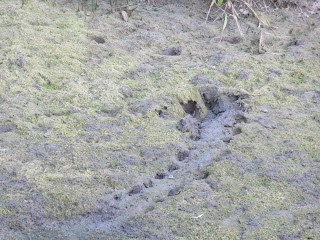The trees are definitely changing colors. The elms are dropping all their leaves now, but the cottonwoods seem to be a lot more individual.we often see migrating birds forming these swirling circles before heading off in a certain direction. I have seen geese, cranes, ravens, seagulls and these vultures doing this behaviour. It's probably some sort of navigating. The hummingbirds are almost gone now.out on the mesa, the roadkill is attracting ravens. The increasing number of buildings is attracting other birds; this is a regurgitated pellet from an owl at the UNM west building.the low ditch water levels is not all sad, the water level is removing many invasive species, such as these golden clams.this red swamp crayfish is a prolific predator because they are adaptable. This juvenile did not dig a burrow and perished
not all is death and destruction; the newly exposed mud is perfect for these milfoil plants, which admittedly will grow to become pretty prolific, without controls.
These flickers are very noisy and have very distinctive red tails and wings
A classic alarmed roadrunner upright poise
The great herons are definitely attracted to the small pools of fish that are left. My dog found a large fish head that had fallen from the sky into our yard. It happens. in the irrigation ditches, the fine clay sediment also traps water as it recedes, allowing animals time to gorge on trapped animals before the water dries up.
These tracks are likely from a large snapping turtle, burying into the mud and pond weed for the winter.









I also saw a flock of cranes flying south yesterday morning over in Western Meadows (North Rio Grande). Probably 100 of them.
ReplyDeleteThe sounds of the cranes and geese always so welcomed! Nice living along a major flyway. Those birds circling upward: catching rising hot air--thermals--to gain altitude with less energy. Great observations, thanks.
ReplyDelete